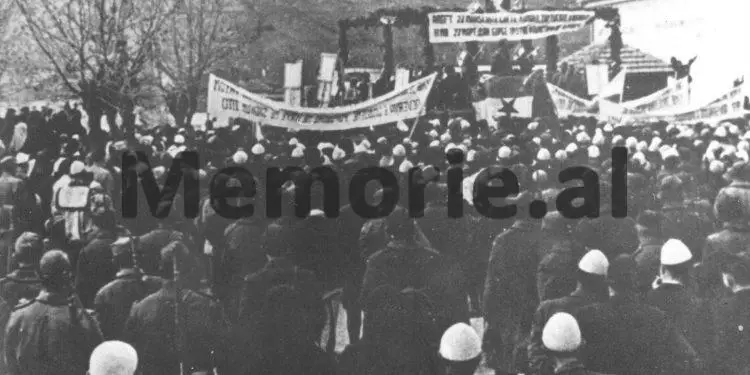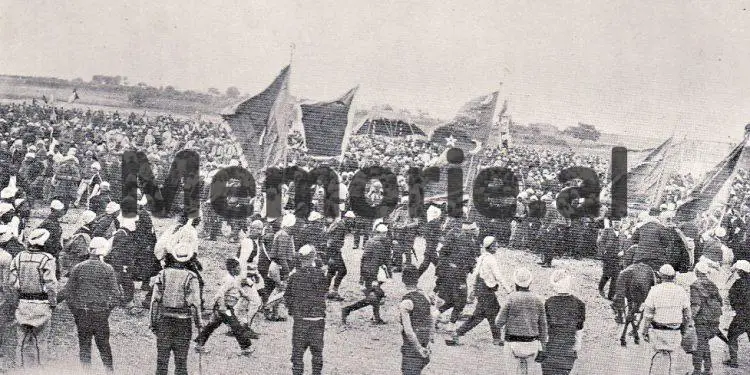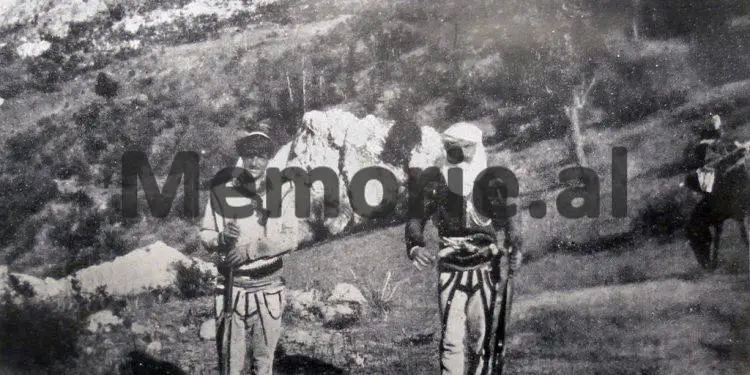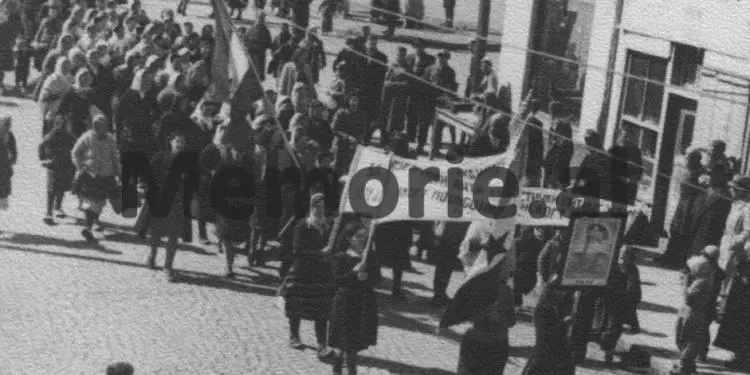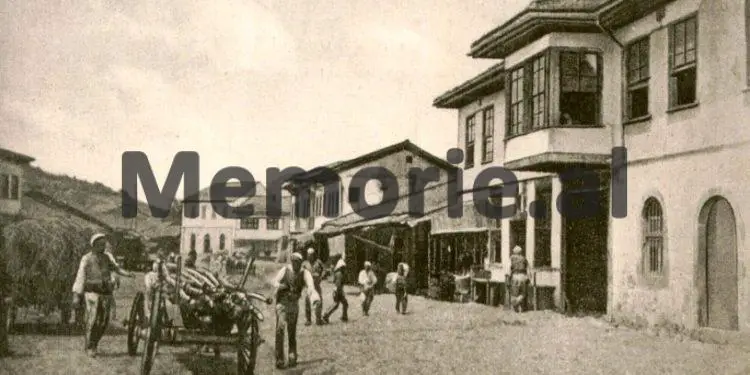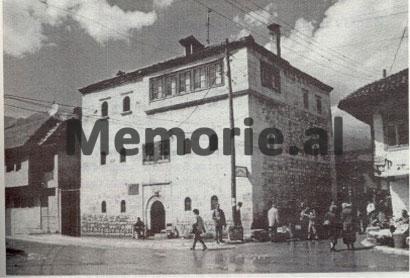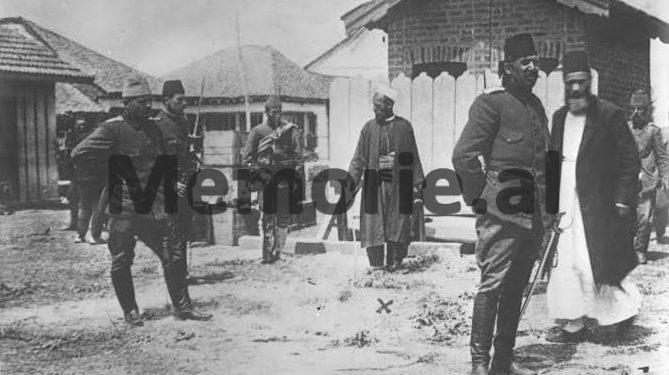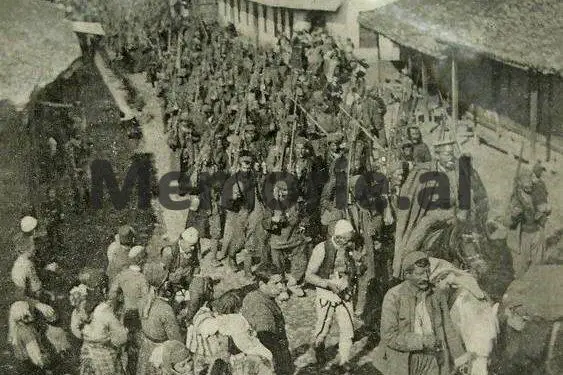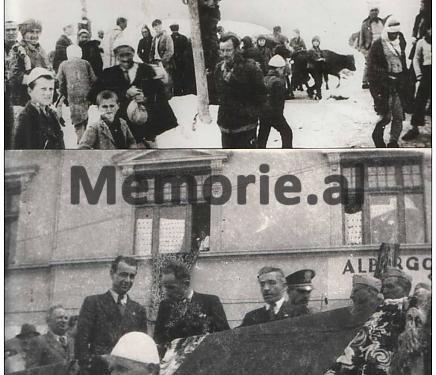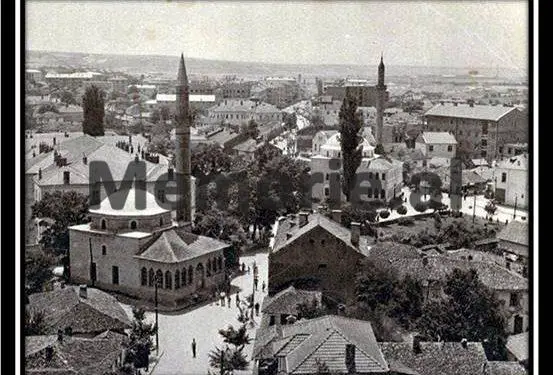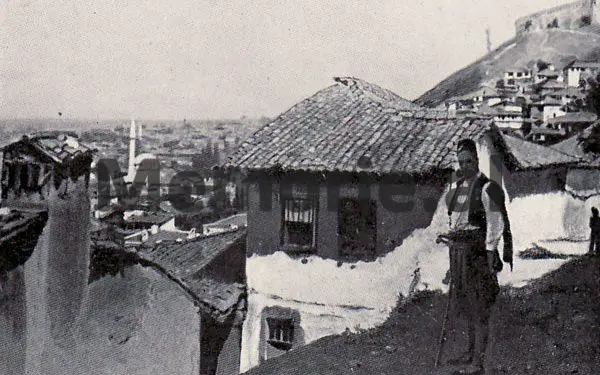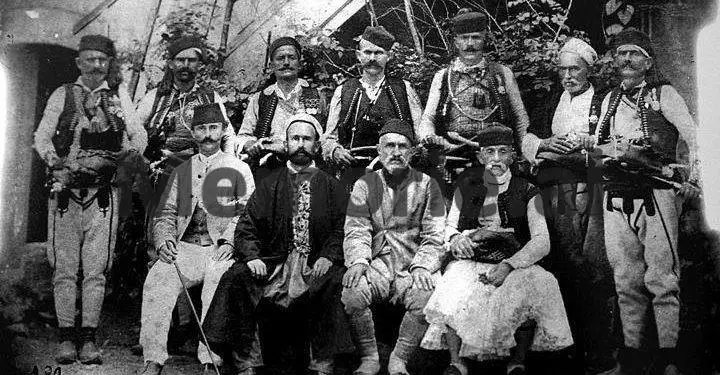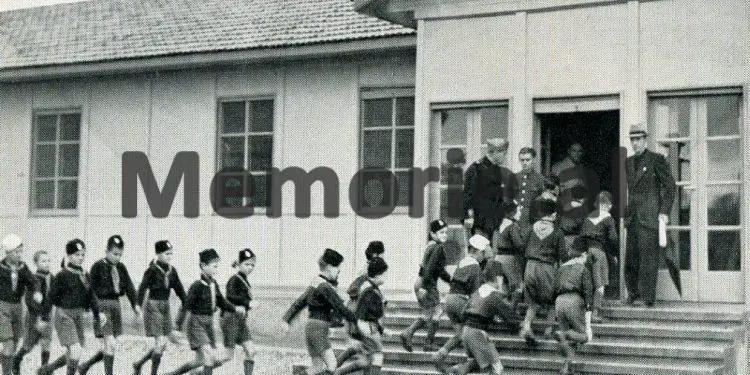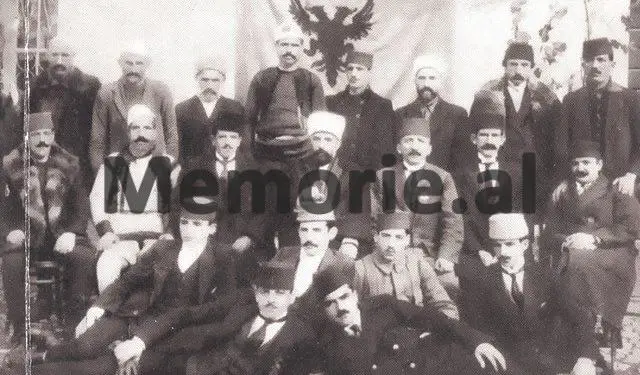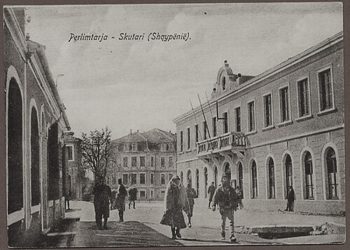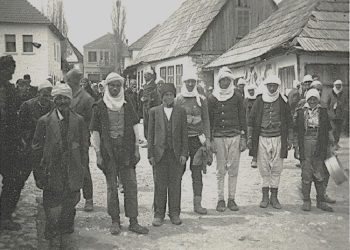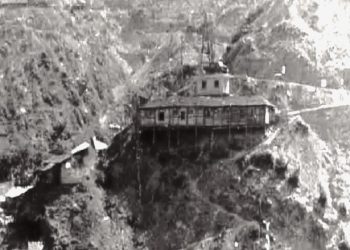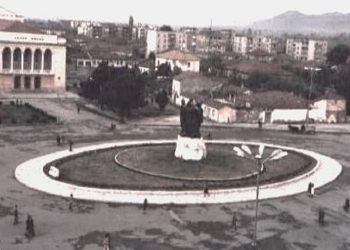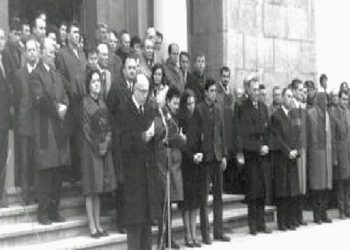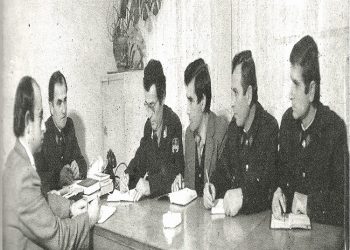
By Sherif Delvina
Memorie.al/ In the Serbian literature so far, even partly in the Yugoslav and Western literature, it is understood under the influence of the first literature, the prevailing opinion is that in the territory of today’s Kosovo, and in the western part of today’s Macedonia, the history of Albanians dates back to the so-called “great Serbian influx with the Patriarch of Peja, Arsenijen III Chernojevic at the helm” in 1690, in which case the Serbs allegedly left these areas completely, and in the “remaining places Albanians were attacked from the mountains of Albania” (Skënder Rizaj, Kosovo during the XV, XVI, XII centuries). The above Serbian thesis is rejected by Prof. Skënder Riza in the above work analyzing the administration, economy, society and popular movements in Kosovo during the XV, XVI, XVII centuries and also prof. Selami Pulaha and other scholars. You are impressed by the book “The Balkans, the History of Bulgaria, Serbia, Greece, Romania and Turkey”, authored by Neville Forbes, Arnold. J. Toynbee, D. Mitrany, D.G. Hogarth published by Oxford at the Clarendon Press, 1915, This book has been reprinted several times. We are getting the 2004 edition from Globusz Publishing, New York – Berlin 2004. The chapter “Serbia” written by the author Neville Forbes, we quote from the topic of this chapter “Turkish rule, 1496 -1796” a passage: “During the war that followed with their defeat, where the victorious Austrians penetrated deep into Skopje from the south, the Serbs also took part in the war against the Turks; but when the Austrians were forced to retreat, the Serbs, who had revolted against Turkey by order of their Patriarch, Arsenius III paid dearly for that participation which resulted in a complete exodus, with the Patriarch at the head towards the Austro-Hungarian military border. This time it was the heart of Serbia that was left to the mercy of fate, that is, old Serbia and Northern Macedonia, including Pec (Peja) and Prizren. The emptied patriarchate was filled with Greeks, while the Albanians, most of whom were Muslims or, to be more precise, Turkophiles, spread to the north-east, to places that had been Serbian lands since the 7th century. What was said above by Neville Forbes is refuted by history.
It is surprising when you read the book of Prof. Dr. Rexhep Krasniqi “Congress of Berlin and the Renaissance of Albania”, doctoral thesis, Vienna, July 1934, republished in Tirana 2007. In this doctorate, prof. Dr. Rexhep Krasniqi states: “In the seventeenth century, under the leadership of the Patriarch of Peja Arsenije Chernojevic, Serbs largely emptied their lands and emigrated to southern Hungary, while the second wave of Serbian emigration was completed in the eighteenth century. our era. In these provinces, voluntarily liberated from the Serbs, Albanians entered who, under extremely difficult conditions, had only from the Christian part of the western world as well as from the coastal centers caused by centuries of isolation, by themselves, easily meant their conversion to Islam. … The Albanians occupied not only the side of Drini i Bardhë and Kosovo, but also further, they entered from the north to Novi Pazar, Nis and Vranja. In the middle of the 18th century, the direction of the Albanian influx changed direction towards Macedonia. ” Unfortunately, even in this book we have the influence of Serbian chauvinist literature.
But what is the truth?
Noel Malcolm in “Kosovo a Short History” (London, 1998), informed us that the defeat of the Balkan coalition in Kosovo in 1389, the Serbs have turned into national myths periodized in three parallel theological phases. The first phase of Serbian national religious mythology is based on the chronicles of monks. This ends with the crucifixion of Christ. For the Serbs, its culmination comes when Prince Lazar Hrebeljanovic stands among the dukes, predicting the betrayal of Judas, who is his son-in-law Vuk Brankovic, who betrayed him the next day, and Prince Lazar, who has taken the place of Christ. will punish him for losing the battle in the next world! In fact, Prince Lazar spent the whole night before the battle of Fushë Kosovë / Kosovo Polje, emptying his glasses full of wine. These chronicles of monks contradict reality. And here is what happened: our consecrated prince was captured by the Ottomans and executed by order of Sultan Bayezid. His martyrdom ended with his cry to God, “O God, receive my soul to heaven!” This call is followed by the beheading of the Turkish janissary. The second phase begins with the burial of Christ (Lazarus) and the flight of the Serbian people from Kosovo, to “Velika Serbia” (Vojvodina), during the Austro-Ottoman war. Kosovo in the Austro-Ottoman war fought side by side with the Austrians against the Ottomans. It has always been inhabited by the vast majority of the Albanian population. Hans Dernschwamse (1494-1568) in “Diary of a Journey to Constantinople and Asia Minor” (prepared and annotated, according to an old manuscript found in the Fuqer archive by Franz Babinger, Munich and Leipzig, 1923, page 8), writes: “Serbian or a Slavonic language is still spoken near Nis”. Further, this author of this voluminous manuscript, on page 258 states that: “Between Bosnia and Bulgaria lies Albania, whose inhabitants are called Arnauts by the Turks.” In Kosovo before Islamization, the majority of the population was Orthodox and not Catholic. For this, Dr. Muhamet Tërnava in “The population of Kosovo during the XIV-XVI century”, (Prishtina, 1995), refers to Cirio Gianiell in “Unpublished documents of the situation of some Catholic communities in Southern Serbia in 1578, volume II, Rome, 1953, which states: “As for the pre-Turkish Catholics, who were natives, a seventeenth-century rapporteur writes:” Of these (MT-Catholics) few lived in those places where Christian princes ruled, because they and all the people had fallen into schism, which continues to this day with persistence “(I. Zamputi, Relation I, 177). From the percentage of Islamized population we are listing a majority of cities at the end of the XVI century: “Shkodra 100%, Peja 90%, Vushtrri 80%, Elbasan 79%, Tetovo 71%, Kichevo 65.5%, Kruja 63%, Berat and Prishtina 60 %, Prizren 55.9%, Dibra 51%, Tepelena 50%, Përmeti 41%, Novobërda 37%, Struga 24%, Vlora 23%, Korça and Trepça 21, Belasica 16.1%, Janjeva 14%, and Delvina 4% (F. Duka, “Religion, culture and Islamic traditions among Albanians”, Prishtina, 1995). We continue with the population of some cities of Kosovo and Macedonia. For this we quote Peter Bartl in “Kosovo and Macedonia in church relations”: “From the beginning of the 18th century until the middle of the 19th century, the population of Prizren, Gjakova and Skopje was almost exclusively Muslim and most of these Muslims were of Albanian origin. In Peja, Novo Brdo, Trepca, Prokuplie, Kratovo, the Muslim population was undoubtedly predominant, but the population there also had a strong Orthodox segment.Janjevo was mostly Orthodox, but in that country the Muslim population was also considerable.The parishes of Guri, Shgjec, Zym and Zogaj in Has near Prizren, they were unequivocally Catholic and Albanian. ” According to “Relacione …” (I. Zamputi, vol. I, p. 339) “Skopje is a very large city that, from Istanbul onwards, few exceed in size. It is inhabited by Turks, most of whom who are Albanians by nationality; others are Asians “. There is wholesale everything, it is 2 days away from Thessaloniki. There are Jews, Serbs and a few Greeks. There are 15 Catholic families who wear a chapel. In 1638/1639 Skopje numbered 23,000 Muslim houses, 120 Jewish houses and 320 schismatic houses (I. Zamputi, cited work, II, 174). In 1641/1642 Skopje had 22,000 Muslim houses, 200 Greek and Serbian houses, and 150 Jewish houses (I. Zamputi, II, p. 262)
For Kratovo the first statistic available to us, taken from Zamputi, “Relations …” II, 174, is that of 1638/1639. At this time, this city numbered 38 Catholic houses, all of Albanian nationality, 40 Jewish houses, 100 Orthodox houses, as well as 300 Muslim houses. Jovan Tomic in his book “Albanians in Old Serbia and the Sandzak of Novi Pazar” (Paris, 1913), describes the Austro-Ottoman war by presenting Kosovo entirely inhabited by the Serbian population, while in fact, it at that time it was inhabited by the vast majority of the Albanian population. We quote this author: “Allied armies, aided only by Serbs, did not penetrate in any direction beyond the borders of the Serbian element. In 1689 the imperialists (Austrian Imperial Army – SH.D.) entered Sandzak, Kosovo, in the province of Peja, Gjakova, Prizren, they descended on the river and along the Vardar valley.In all these directions the insurgent Serbs, free in their movements in the places inhabited by their race, were the vanguard of the imperial army … everyone welcomed Piccolomini, both the Catholic and Orthodox Serbs of the Prizren countries, as well as the Islamized Serbs of this city.
Here is what the documents tell us:
In the documents of the Austrian command, in the memorial on Albania dated April 1, 1690 of General Marsigli, member of the staff of the Austrian army, in the letters of the Catholic vicar of Skopje, Thoma Raspasani who replaced the leader of the Albanian insurgents, the Archbishop of Albania, Pjetër Bogdan it is proved that “Prizren was the capital of Albania”, that “Peja and Skopje were included in Albania” that in the areas of Kosovo the Albanian language was spoken. The Emperor of Austria Leopold I himself emphasized that his armies fought in Albania (when they entered Kosovo) etc. (Archive of the house, courtyard and state of Vienna, archive of the war, documents of the battle 1689) (Quoted by Selami Pulaha “The Albanian population of Kosovo during the XV-XVI centuries”). In the work “History of Turkey”, written by M.Knolles and continued by the venerable Sir Paul Ricaut, (volume II, London, 1701), talks about the involvement of Albanians in the Austro-Ottoman war regardless of religion. On page 323 of this volume, the authors note that the Commander-in-Chief of the Austrian Army, Count Pikolomini, meets and is received with honors by the local population in Prizren. Regarding this historic meeting, these authors claim: “At this time, although the fever increased, Piccolomini continued his march to Prizren, where he met with the Archbishop of Albania and the Patriarch of Kelmendi. This was accompanied by 8,000 Arnauts, from Greeks of Albania, (Albanian Orthodox – Sh.D.), Turks (Muslim Albanians – Sh.D.) and other Christians of this country, who declared their determination to live and die with them on the common cause against the Turks why had sworn allegiance “(to Emperor Leopold – Sh.D.). Even Jovan Radonic in the aforementioned work proves that Piccolomini was received in Prizren by 6000 Albanians. The paragraph translated from the original is accompanied by the subtitle “Arnauts Return to Empire”. This meeting we talked about above took place on November 6, 1689 in Prizren. The Archbishop of Albania and Patriarch of Kelmendi was Pjetër Bogdani, while the Serbian Patriarch (Arseni III), has been confirmed fourfold that he was not in Prizren. Augusto Theiner’s “Old Monuments of the South Slavs” (volume II, published by the Academy of Sciences of the South Slavs, Zagreb, 1875, pp. 212-214. Ç VIII), provides a report on the state of the congregation the missions of Propaganda Fides “, written for Pope Innocent XI by Monsignor Urbano Cerri (Çeri), around 1680. This document states that the Bishopric of Shkodra includes the people of Kelmendi who depend on Pjetër Bogdani. The term” the people of Kelmendi “means the whole Malësia e Madhe, which at that time consisted of Kelmendi, Hoti, Gruda, Trieshi, Kastrati, Bërda, Kuçi, Pulabardhi, Piperi, Vasojeviçi, some of them were Albanian Orthodox, who today are Slavicized. Catholics, or converted to Islam, remained Albanians.The Archbishop of Albania, Pjetër Bogdani, devised a project for the liberation of the homeland and tried to reach an agreement with the Austrians for its realization. “Count Pikolimini was received by the Archbishop and Patriarch of Prizren”, refers on November 29, 1689 the ambassador of France in Vienna. An agreement was concluded with Piccolomini. The treaty stipulated that local volunteers, as well as half of the rebel inhabitants, would be organized in the Austrian manner, while the other half would stay at home, but all would be under the emperor’s protection. (“Kosovo a Short History”, Noel Malcolm, 1998, London). Regarding the title of P. Bogdani “Archbishop of Albania”, mentioned by most contemporary authors, it is nothing but the title Archbishop of Skopje, a title he enjoyed until the day of his death, December 6, 1689. (Pjetër Bogdani , “Letters and documents”, Odette Marquette, Shkodër, 1997). P. Bogdani at that time also headed the Albanian Orthodox Christian brotherhood. And the Slavic historians, the Albanian Orthodox of Northern Albania of that time, as well as of any time, unjustly call them Serbs. Serbs, like Greeks, equate religion with nationality. In 1689 the city of Pristina consisted of 15,000 people, most of whom were Muslims. Here Piccolimin entered without a fight. According to documentary sources, 5,000 Arnauts fled from the Turks and sided with the Austrians. Hammer in “History of the Ottoman Empire from its organization to the present day”, (vol. XII, Paris, 1835, p. 502-503) on the mobilization and participation of the Turkish army in the Serbo-Ottoman war of that time writes “In a war council held in Adrianople, attended by the Crimean inn, Selim Ghirai (Girei) and Toekoeli, it seemed urgent to march towards Skopje where the enemy assisted by the Albanians and their Patriarch (Pjetër Bogdani – Sh. D), had set up his general headquarters … In Prizren gathered 7 or 8 thousand German, Hungarian and Albanian men, all holding on their chests a cross, to better show the purpose of this war “. The above-mentioned author points out that, at this time, the Ottoman Empire sent instructions and orders to all Christians of the Ottoman Empire, in which it was ordered to deduct any tax burden from Ottoman Christian subjects, so that they would not be forced to paid taxes other than the usual ones. These ordinances were issued by Mustafa Qypriliu, the then Vizier of Turkey, and as Hammer points out, “supported the repressed rajah. ease in the work “Albanians and Slavs”, (Lausanne, 1919, “Central Library of Nationalities”). For this Mid’hat Frashëri used the antique “New Open Gates”, written by Ricaut, Donaldo Foscarini, Berengano etc. (Ausburg, 1701). This work talks about the Austro-Ottoman war. On page 62, talking about Prince Carl Philip, it is stated that Prince Carl Philip was in Pristina, Albania, at the beginning of 1690. On pages 517-518 of this antiquity it is stated: “With the rest of the troops consisting of two regiments, the general himself went, without noticing the feeling of inadequacy in Prisseran (Prizren), the capital of Albania, where the archbishop and the patriarch of Kelmendi were … where there were 8000 Arnauts, partly Christians and partly Turkish-Albanians (Muslim Albanians – Sh.D.) … “Meanwhile the enemy had begun to strengthen in Lume and Tetovo. For this, the Christian part, as soon as it received the news in the city of Prisseran (Prizren) they were hit by some Albanian troops … “. Page 460 states:” No less eager was the Albanian province to remove the Ottoman yoke, as well as Guzzini (Gucian), Klementinë (Kelmendas) and other peoples (tribes – Sh.D.) of Albanian settlements … “. So, the lie of Serbian chauvinist historians, who say that Kosovo at that time was Serbia, is refuted fourfold by Lumo Skëndoja: The international opinion is enlightened by such valuable documents published by Lumo Skëndoja. On the contrary, Pikolomin’s army was harmed by Serbian thieves, Russians from Rasha, who went to Pikolomin’s aid. These thieves (bandits) were divided into 300 people were burned and looted in Kosovo.Austrian soldiers also began to take part in these lootings. These behaviors did not go unanswered by the locals. in the attainment of peace “, (described by Camilo Contarini, Venetian nobleman, part II, Venice, 1710 page 170) states:” Holstein urges the inhabitants of the River to honor Caesar (Leopold I), they do not accept it “. The above-mentioned author writes: “Duke Holstein, following the Turks, entered the country between the two Drines, which was inhabited by highlanders. With promises of tax and privilege abolition, he invited the inhabitants of that country to pay tribute to Caesar (Leopold I – Sh. D.). Not only did they not accept the promises made to them by Duke Holstein, but they wanted to support the infidels (Turks), even though they were of the Orthodox religion.They, without playing from their positions, waited for the arrival of The Germans, acting in this way, angered Holstein and he was rightly angry, and ordered that the whole territory be set on fire. “Over 30 villages on that side were reduced to ashes. After carrying out this action, he crossed again to Prizren and then arrived in Prishtina with a forced march.”
After Piccolomini died, Albanian recruits became dissatisfied with the anarchy, stinginess and arrogance of Austrian officers. The commander of the Austrian army in Kosovo, Duke Holstein, demanded that Albanian soldiers pay taxes as well as disarm. “This was intolerable for that free and warlike nation,” Venetian sources tell us. Peja, which was the seat of the Serbian Patriarchate, was also part of Albania. Let us quote a document of that time: “General Veteran, seeing that his plans were successfully realized, ordered Colonel Antonios to make observations as far as Peja, a city in Albania.” (Documents of the Xvi-Xvii centuries for the History of Albania, Volume IV (1675-1699), Tirana, 1990). Document 146 “1689-1690 – Excerpts from the Diary of an anonymous entitled:” Notes and meditations on the glorious imperial weapons in 1689. ” Hahn in “Reise von Beograd nach Salonik Wien, 1868” points out the strict behavior of arbitrary taxes and the lack of discipline towards his soldiers by Piccolomini’s successor, Herzog von Holstein, made the Albanians abandon him and cross over to the Ottomans. Of the 20,000 Albanians who joined Piccolomini in Kosovo, only 3,000 remained in his army. After a short time, the Austrian army was disbanded. It, under the blow of the Ottoman army in 1691, was forced to retreat to Hungary. “More than 40,000 people took refuge there,” wrote the Serbian Patriarch of Peja, Arseni III, in 1706 to King Leopold of Austria. “This number included 30,000 Serbs who left Serbia for Hungary, after Belgrade fell to the Ottomans in 1696. The rest of the refugees were from Nis. This number also included Albanian Catholics from Kosovo, Albanian Muslims from the same country, as well as Slavic Muslims, informs us in 1693 Tom Raspasari, who replaced Pjetër Bogdani, referring to the Austro-Ottoman war of 1689. One of the main forgers of the emigration of Serbs from Kosovo is Lubor Niederle. “Slavic Race” (statistics, demography – anthropology, Paris, 1916, page 172), he writes: fled from there, fleeing settling in the relatively quiet provinces of Austro-Hungary. This displacement started at the end of the 14th century, after the battle of Kosovo (1389) and the capture of Skopje (1381) by the Turks. “According to historical documents belonging to this period, presented by Serbian historians, there is no Serbian displacement., even imaginary from Fushë-Kosova before 1689. Even at that time there was no Austro-Hungary. Further the above-mentioned author writes in this book, Raczka, in the lands of Torontal and Temesvar. “After these lines L.Niederle continues to deceive:” The great emigration to these lands took place in 1690 under the leadership of Arsen III Chernojevic, patriarch of Peja.
They say that there were 8000 people. “This lie is refuted by Arsenius III himself, who in his letter to Leopold I, quoted earlier, which speaks of Serbian emigration after the Austro-Ottoman war at the end of the 17th century, gives us the number of 30,000 Serbs, but they too are not Serbs from Kosovo Ami Boue, in volume IV “Turkey of Europe” (Paris, 1840), states that the northern Albanians, Muslims and Catholics, hope to form a Skanderbeg-like principality , under the protection of Austria “. This scholar says this, wanting to renew the Austro-Albanian friendship of 1689, the basis of the future formation of an Albanian principality under the protection of Austria. For the sake of truth it is It is fair to say that the lies about the great Serbian immigration of 1689-1690 are, after all, falsified chronicles written in Serbian monasteries, regretting that in Robert Mantran’s “History of the Ottoman Empire” (Paris, 1984, edition of Fayard), states that “Arsen III Cernojevic after the withdrawal of the Austrian army, was forced to flee along with part of its people – about 90,000 families – north of the Danube. ” This author repeats the Serbian refrain of deception. It is worth mentioning A. Yelen’s book “In Orthodox Yugoslavia”, Chapter II entitled “Migratory Movements”. In this chapter the author has published the letter of Patriarch Arsen III sent to Peter I, we read a paragraph:
“Day and night with the unlucky people
I have no place anywhere but to flee,
Like a ship in the endless ocean
Waiting for the sunset
And the end of the day.
Waiting for the night to end
And our wild winter…
Therefore, let us say by weeping:
Get up, Lord
How long will you leave us abandoned?”
(Arseni III Chernojevic) (excerpt from his letter to Peter the Great, October 29, 1705. On page 111, Mrs. Yelen writes: “In the deserted lands the Turks established new settlements, starting first with the soldiers and in the province of Skadar (Shkodra), the Albanians filled the gaps left by the departure of the Serbs, the shepherds of Asia Minor and the Muslim Albanians arrived in Macedonia. We inform the author that according to the Ottoman cadastral records, which date from the 15th century to the end of the Ottoman rule, the Albanians never filled the gaps left by the Serbs, they were autochthonous as in Kosovo, Western Macedonia as for the province of Shkodra, the Venetian cadastral registers, which highlight the autochthony of the Albanians in this province, speak clearly about the displacement of Serbs. Speaking of the Austro-Ottoman War on page 117 of this book, we quote a paragraph: “When in 1690 Arsenius III took with him more than 40,000 men on a long march to Hungary, as he had captured the 50s. He was a man full of dignity, courageous and strong in hardship, with great qualities that characterize Montenegrins. ” Nikola Jorga notes that the Chernojevic family is of Albanian origin; while my “unlucky” people, as Arseni III calls the displaced people he took with him, only reached the figure of about 40,000 people.
As L. Thallozcy writes: “The plains of Slovenia and that of Southern Hungary absorbed like oil the invasions that came from the Balkans in 1960 and therefore, we cannot talk about real colonization. Among the emigrants, there were also farmers from different parts, who according to Eastern tradition worked as much land as they needed to support themselves; among them were merchants – most of them Greeks and Vlachs and some wealthy (Serbs), then there were armed groups of Serbs and Albanians, who in their country had served as mercenaries and who now sought to live by theft and looting… Like all shepherd peoples, they did not feel they were doing any regular work (Thallozcy, Illyrisch-albanische Forschungen, Munich, 1916). Thallozcy shows very clearly that the so-called emigration of Serbs from Kosovo in 1960 was nothing but a migration of various elements; of Serbs, Bosniaks, Herzegovinians, Albanians, Vlachs and Greeks. Selami Pulaha in “Autochthony of the Kosovo Albanians (Tirana 1985), analyzing the Serbian exodus of 1689, based on the Ottoman cadastre, concluded that in Kosovo the Islamic religion spread to the Albanian Orthodox and Catholic population and not to the Slavic minority although lived in the same conditions. It is worth mentioning the Venetian cartography MV Coronelli (1640-1715. In his map “The flow of the rivers Drini and Buna”, Venice, 1688, gives for some settlements given the religious and ethnic structure of Kosovo, for example: Prizren is inhabited by 6000 and 35, while Skopje has 20000, 25 and 200Δ, Janjeva 5000 and 80, (= Catholic; Δ = Greek, = Turkish) It should be borne in mind that Turkish religious identification refers to the Muslim population, while the Greek refers to the Orthodox population, so from what we have seen above, it is clear that the vast majority of the population of these cities is Albanian.In another Coronelli map entitled “Danube Stream from Vienna to Nikopoja”, v neighboring countries, Kosovo is identified with the name Iliricum. Phase III of Serbian religious mythology, begins in 1878 and ends in 1999 with an undeclared war of Serbia against Kosovo, with a balance of hell: hundreds of thousands of Kosovars killed, looted and displaced, burned, destroyed, raped, etc. The third phase responds to the revival of the Serbian people, which is the reconquest of Kosovo. This criminal mythology unfortunately led the Serbian people to commit crimes against the Albanian population of Kosovo, making them a permanent collective accomplice in the Kosovo tragedy. The burial of this criminal mythology will take place on February 17, with the declaration of Kosovo’s independence./Memorie.al
Sherfi Delvina
Scholar, Historian, ‘Teacher of the People’




